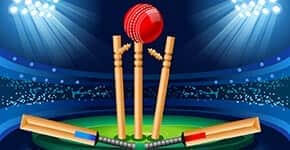Cricket Glossary
There is no sport that gets even close to cricket when it comes to quirky terms and expressions. While many consider this a charming trait, and one in keeping with a sport that dates back to the 18th century, for any newcomers to the sport it can be confusing and bewildering. From silly points to flippers to gullys, cricket has a language all of its own and in an attempt to unravel some of its mysterious sayings we have pulled together a glossary. We’re almost guaranteed to have missed some (new ones pop up all the time) but hopefully we have covered most.

Cricket Terms:
Arm Ball – Bowled by a slow bowler, this ball has no spin and so does not ‘turn’ as you would expect. Instead it stays on in a straight line, which is known as ‘going with the arm’.
The Ashes – The most famous test series in world cricket, played between England and Australia.
Bat-Pad – A fielding position close in to the batsman designed specifically for the fielder to catch balls that pop up off the batsman’s pads (hence the name).
Batter – Another word for batsman.
Beamer – A bowl that does not bounce and heads towards the batsman at or above head height. It is very dangerous and is usually bowled accidentally.
Bouncer – A short-pitched delivery that bounces half-way down the pitch and passes the batsman at above chest or head height.
Boundary -The perimeter of a cricket field that is the ‘target’ for fours and sixes; also the act of the batsman hitting a four or a six (e.g. ‘Kohli hit yet another boundary’).
Bump Ball – A ball that is hit by a batsman simultaneously as it hits the ground. If it is caught by a fielder it has the appearance of a clean catch but isn’t.
Bye – A run added to the total score but when the batsman does not touch the ball with his bat or body and does not count against the bowler’s figures.
Cross bat – A shot where the batsman holds his bat horizontally – as opposed to vertically – when striking the ball. Examples include hook shots and pulls shots.
Declaration – When a batting side takes the decision to end their innings before all of their players are out.
Doosra – An off-spinner’s version of the googly; delivered out of the back of the hand and therefore turns away from a right-handed batter.
Drifter – A delivery bowled by an off-spinner that curves away from a right-handed batter in the air and then carries straight on instead of spinning.
Duck – A score of 0 by a batter.
Duckworth-Lewis – A scoring system devised to help decide one-day cricket matches when rain or bad light interrupts play. It is name after Frank Duckworth and Tony Lewis, who invented the system.
Economy rate – The average number of runs that a bowler concedes per over.
Extras – Runs that are added to the total but not scored by the batsmen. There are four types – byes, leg-byes, wides and no-balls.
Flipper – A variation by a leg-spin bowler that appears to be pitching short of a length but skids on very quickly making it a difficult ball for the batter to defend.
Full toss – A ball that reaches the batsmen without bouncing on the pitch. If it goes past the batter above his or her waist it becomes a beamer and is usually bowled by accident.
Good length – The perfect length that bowlers aim for where they attempt to get the batter in two minds as to whether to play forward or back.
Googly – A variation bowl by a leg-spinner, which turns into the right-hander and away from the left-hander.
Gully – A close fielder near the slips, at an angle to a line between the two sets of stumps of roughly 100 to 140 degrees. Sometimes called the sixth slip.
Half volley – A ball that is a perfect length for a batter to drive; fuller than a good length delivery but short of being a full-toss and ideal for smashing to the boundary.
King pair – When the batter is out first ball in both innings.
Leading edge – When the batter mis-times the ball and it hits the front edge of the bat and goes off in an unintended direction.
Leg-Before Wicket (LBW) – A complex rule but one that essentially means the batter is out if the ball hits his or her pads in line with the stumps. It is further complicated by a rule that says if the ball pitches outside off or leg stump it cannot be given out.
Leg-bye – When the ball deflects off a batter’s pad and he or she is able to take a run. The run is classed as an extra and does not count against the bowler or for the batter.
Leg-break – When the ball pitches and turns from leg to off for a right-hander.
Leg-cutter – A ball that cuts and moves away from the batsman towards the off side (if he is a right-hander).
Leg-side – The area of the pitch that is to batsman’s left (if right-handed), or right (if left-handed).
Long hop – A short-pitched delivery that is neither fast enough or high enough to be a bouncer, but which offers the batsman an easy hit off the back foot.
Maiden – An over where no runs are scored that count against the bowler.
New ball – In a test or four-day game a new ball is taken every 80 overs.
Nightwatchman – A lower order batter who gets promoted up the order towards the end of a day’s play in order to spare a recognised batsman from facing the final overs of the day.
No-ball – An illegal delivery, invariably when the bowler oversteps the front crease.
Off-break – A bowl that turns into the right hander, from the off side to leg.
Off-side – The opposite of the leg side.
Out – For batters, there are ten different ways of getting out. Five are well known – caught, bowled, leg before wicket (lbw), run out or stumped – but there are five less familiar ways: timed out, handled the ball, obstruction, hit ball twice, and retired.
Outside edge – When the ball hits the edge of the bat that is away from the batter’s body.
Outswing – When the bowler gets the ball to swing away from the batsman and towards the slips.
Pair – When a batsman scores zero runs (gets a duck) in both innings.
Pull – A back-foot shot by the batter onto the leg-side, different from a hook shot because the pull is played to a ball that hasn’t bounced as high.
Return Crease – Parallel white lines that point down the pitch, either side of the stumps in which a bowler’s back foot must land for it to be a legal delivery.
Reverse Sweep – Not a shot you will in a cricket coaching manual but one played by dropping to one knee and reversing your hands so that you can swing the ball from leg to the off side. Often used in T20 cricket.
Reverse Swing – This tends to occur when the ball is over 50 overs old and the pitch is flat and lifeless. It involves sideways movement of the ball through the air that is against the laws of physics but happens due to the deterioration of the ball and the seam.
Rough – Part of the batting strip that gets scuffed up and loosened by the action of a bowler’s follow-through. It’s usually found just outside leg stump and is therefore a target for spin bowlers.
Run-chase – When a match has been reduced to a fixed figure for victory in a set time or in a maximum number of overs.
Run-rate – In a one-day game, the average number of runs scored per over and used as a guide to a team’s chance of victory.
Runner – When a player is used by a batsman, who might otherwise need to retire hurt, to run on their behalf. They have to wear identical kit to the batter.
Seam – This is the ridge of stitching that holds together two halves of a cricket ball. It is used to cause deviation off the pitch when the ball lands. Seam bowlers rely on movement off the pitch, unlike swing bowlers who look to get movement through the air.
Silly – A modifier to the names of some fielding positions to demonstrate how unusually close to the batsman they are. Examples are silly mid-off, silly mid-on, silly midwicket and silly point.
Sledging – The act of verbally unsettling a batter, often by abusive, offensive and occasionally amusing comments. It is designed to make him or her lose their concentration and give their wicket away cheaply.
Slip – A close in fielder behind the batsman and next to the wicket-keeper on the off-side. There can be as many as four slips for a faster bowler, i.e. first, second, third and fourth slip.
Slower ball – Needs little explanation but is now a key part of a fast bowler’s armoury. The plan is to deliver a significantly slower ball but while turning your arm over at the same speed as for a quicker ball. The idea is to deceive the batsman and is generally achieved by a change of grip or a late tweak of the wrist.
Strike rate – This applies to both batters and bowlers. For the batsmen it’s the number of runs scored per 100 balls, while for the bowlers it’s the number of deliveries they need to take their wickets.
Swing – The amount by which a ball curves through the air, as opposed to off the seam. (See also ‘reverse swing’).
Tail-ender – These are players who come in to bat at the end of an innings, generally they are Nos. 8, 9, 10 and 11, who are not noted for being good batters. Often however they can be the difference between winning and losing a game and they give rise to the phrase ‘the tail wagged’ – meaning the tail-enders scored a useful amount of runs.
Third man – A fielding position on the boundary, behind the wicket on the off side.
Twelfth man – A substitute fielder, who also has the duty of taking out drinks and new equipment to the middle. If called upon to play he or she is allowed field wherever they are needed but can neither bat nor bowl.
Wicket – A word that is central to the game of cricket and has more than one meaning. It is used to describe the 22 yards between the stumps, to describe the stumps themselves (including the bails), the act of hitting the stumps and therefore dismissing the batsman, and, finally, the act of not being out (e.g. Jayasuriya and Kumar Sangakkara put on 167 for the second wicket).
Wide – A delivery that pitches so ‘wide’ the batsman is realistically unable to hit the ball and therefore score off it. The umpire will single this by stretching both arms out horizontally and an extra run will be added to the total. Also the ball will be bowled again.
Wrist spin – A type of spin bowling where the revolutions on the ball are imparted by a flick of the wrist rather than a tweak of the fingers. Generally, a right-arm wrist spinner’s action will turn the ball from the leg side to off while a left-armer turns it from off side to leg.
Wrong ‘un – An Australian term for a googly – a leg spinner’s variation bowl, which turns into the right-hander and away from the left-hander.
Yorker – A full-pitched quick delivery that is aimed at the batsman’s toes and the base of the stumps. If the ball is swinging, these can be the most lethal deliveries in the game and are often used effectively at the end of a T20 innings.




